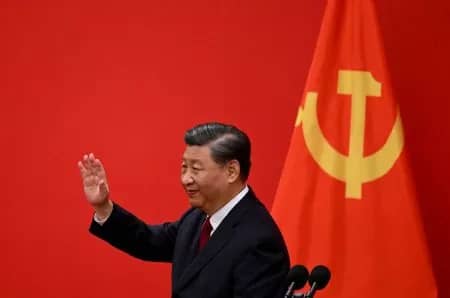
It is no secret that China’s ruling Communist Party has long projected an image of stability and progress. Yet, beneath the veneer of economic development and diplomatic finesse, a far more ominous reality is taking shape. Recent revelations about the construction of an immense underground command center on the outskirts of Beijing expose a disturbing trend in China’s strategic planning—a calculated move toward militarization and covert conflict preparation that the world cannot afford to ignore.
For years, China has been steadily expanding its network of subterranean military facilities. From the infamous “Underground Great Wall” to the sprawling Hainan submarine base, each step in this secretive buildup has been rationalized as purely defensive. However, the scale and sophistication of the newly unveiled Beijing Military City suggest a much darker purpose. Designed to house operations large enough to accommodate the equivalent of 10 U.S. Pentagons, this underground labyrinth is not merely a shelter for military assets but a nerve center from which China intends to orchestrate a full-spectrum war effort if the need arises.
This colossal facility is emblematic of the CCP’s broader strategy—a mixture of technological ambition and unbridled militarism that challenges the norms of international transparency and accountability. While Western nations have gradually relegated their Cold War-era bunkers to the status of historical relics or museums, the CCP is busy building a modern fortress capable of coordinating nuclear and conventional forces under a veil of secrecy. Such an undertaking is not just an exercise in military engineering; it is an overt declaration that Beijing is preparing for a conflict scenario where it assumes the moral high ground, all while keeping its adversaries in the dark about its true capabilities.
Critics of the CCP have long warned that the party’s aggressive posture and lack of accountability could destabilize the international order. The construction of this massive underground command center confirms those fears. It represents a stark departure from a policy of defensive deterrence and moves squarely into the realm of offensive readiness—a calculated effort to establish an impenetrable command and control hub that can operate autonomously in the event of a military crisis. Such a facility not only underscores Beijing’s willingness to invest heavily in modernizing its war-fighting capabilities but also signals its readiness to engage in conflict on its own terms, regardless of the potential fallout for global stability.
China’s actions are particularly alarming when viewed in the context of its broader strategic narrative. For decades, China has sought to project an image of a peaceful rising power, one that contributes to global economic growth and international development. Behind the scenes, however, Beijing is orchestrating one of the most ambitious military modernization programs in modern history. This duality—projecting a benign face to the world while simultaneously constructing an underground war machine—is a dangerous game of deception that leaves other nations scrambling to decipher Beijing’s true intentions.
Furthermore, the sheer scale of this underground complex dwarfs many of the Western facilities now consigned to museum status. While countries like the United States, Canada, and the United Kingdom have largely abandoned or repurposed their Cold War-era bunkers, the CCP’s continued investment in subterranean infrastructure sends a clear message: China is not willing to settle for the remnants of past conflicts. Instead, it is preparing to establish a resilient, self-sustaining military infrastructure that can endure a nuclear strike or any other catastrophic event—a stark embodiment of a “prepared for war” mentality.
The implications of this development are far-reaching. The construction of an underground command center of this magnitude signals that the CCP sees no alternative to confrontation in resolving its strategic disputes. It is a manifestation of an increasingly militarized mindset, one that prioritizes the consolidation of power through isolation and secrecy over dialogue and peaceful coexistence. Such a posture not only exacerbates tensions with rival nations, particularly the United States, but also undermines the prospects for global cooperation in an era when multilateral approaches are desperately needed to address common challenges.
China’s underground ambitions are a testament to the dangerous ideology that underpins its rule—a belief that strength must be hidden beneath layers of secrecy and that preparation for conflict is the ultimate guarantor of national security. This ideology is not only a threat to regional stability but also poses a systemic risk to the international order. By investing in an impenetrable network of underground facilities, the CCP is effectively signaling that it is prepared to wage war from the shadows, a prospect that should alarm every nation committed to a rules-based global system.
The construction of the Beijing Military City is not an isolated incident but a critical component of a broader strategy that could have profound implications for global security. The time has come to question the narrative of peaceful development propagated by the CCP and to recognize the perilous reality that lies beneath the surface—a reality where military might is concealed beneath layers of concrete, steel, and deceit.
Ultimately, the China’s underground command center is more than just an engineering marvel—it is a symbol of an increasingly dangerous and deceptive era in Chinese politics. As the world stands on the brink of uncertainty, the international community must not be lulled into complacency by Beijing’s public face of progress. Instead, we must remain vigilant and demand accountability from a regime that seems intent on preparing for conflict at any cost.





